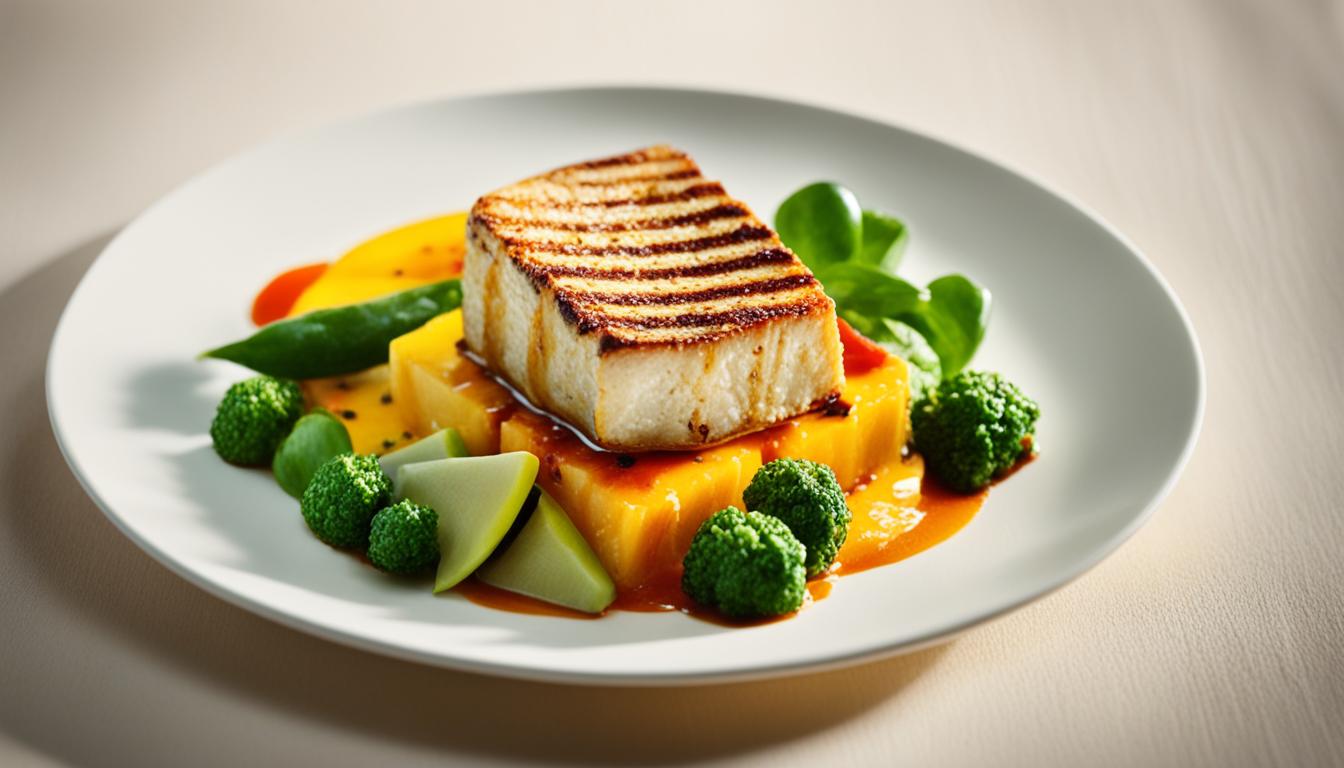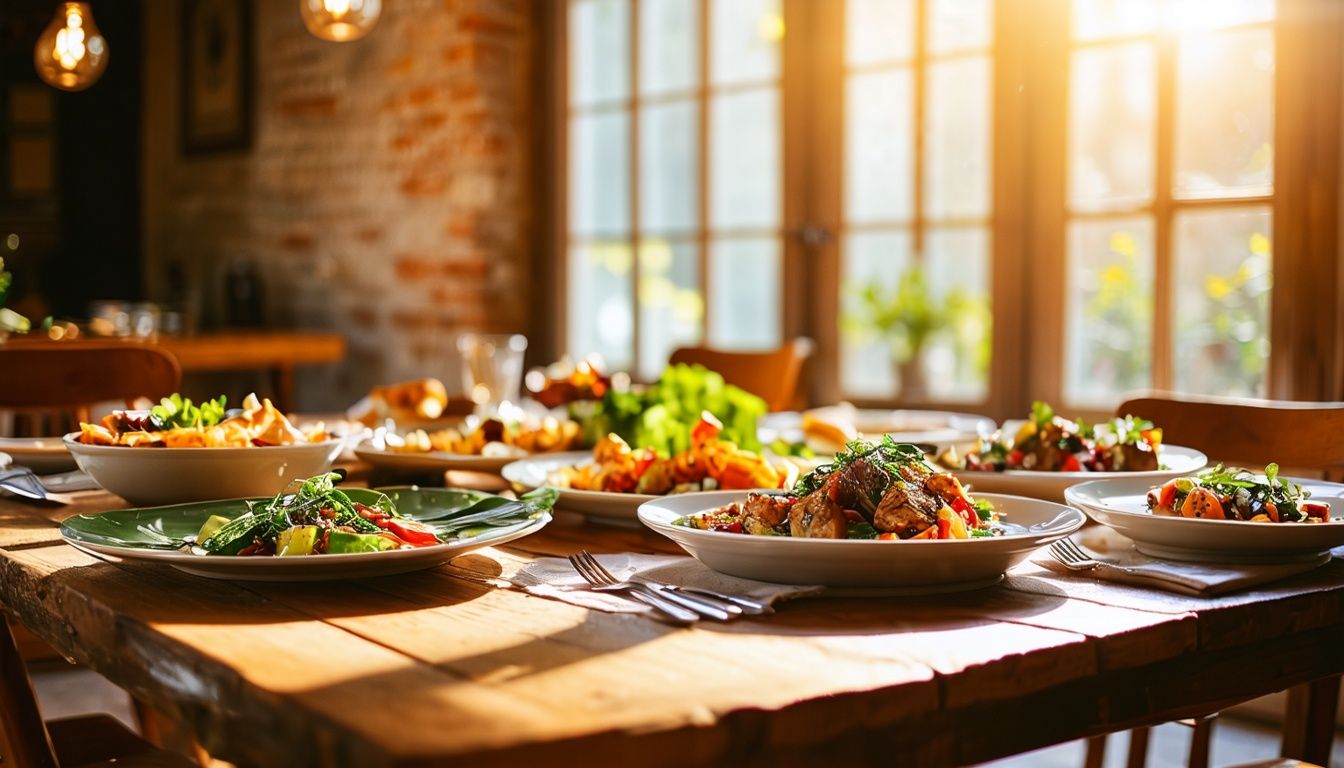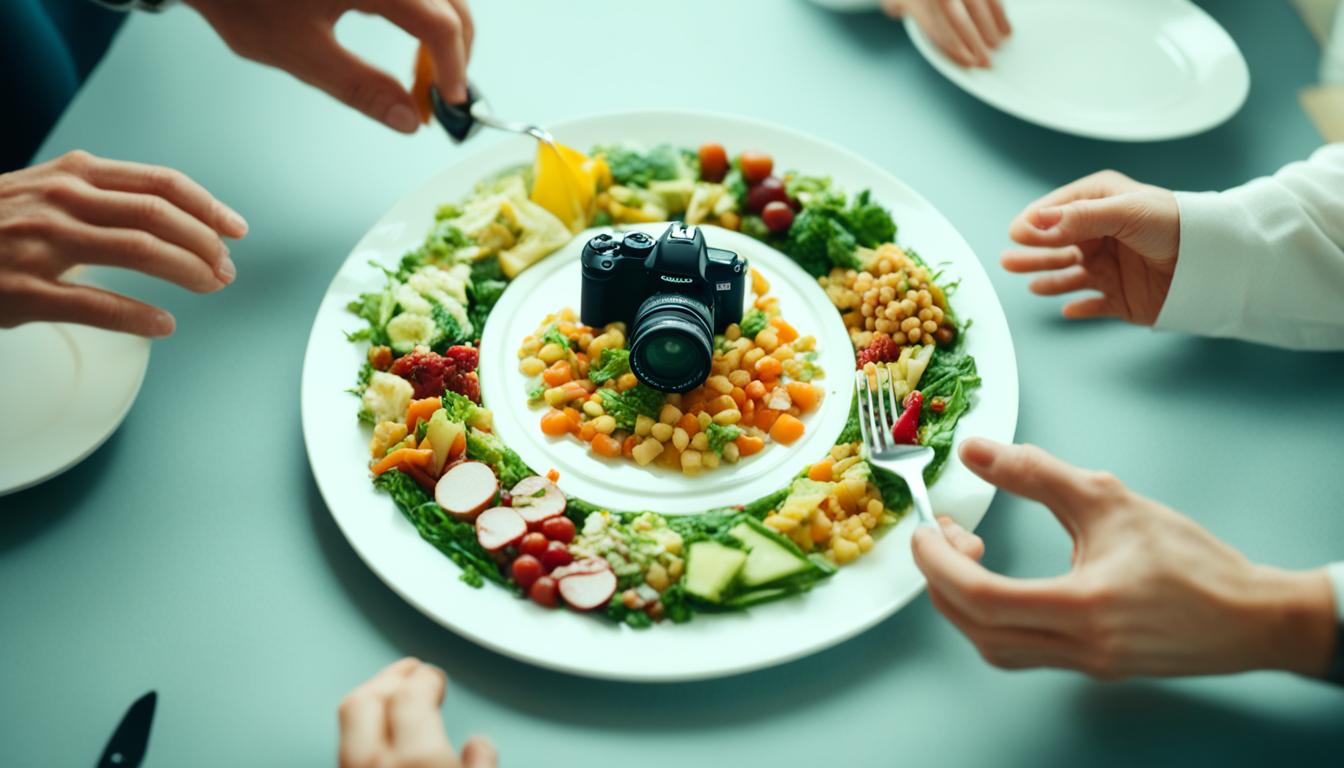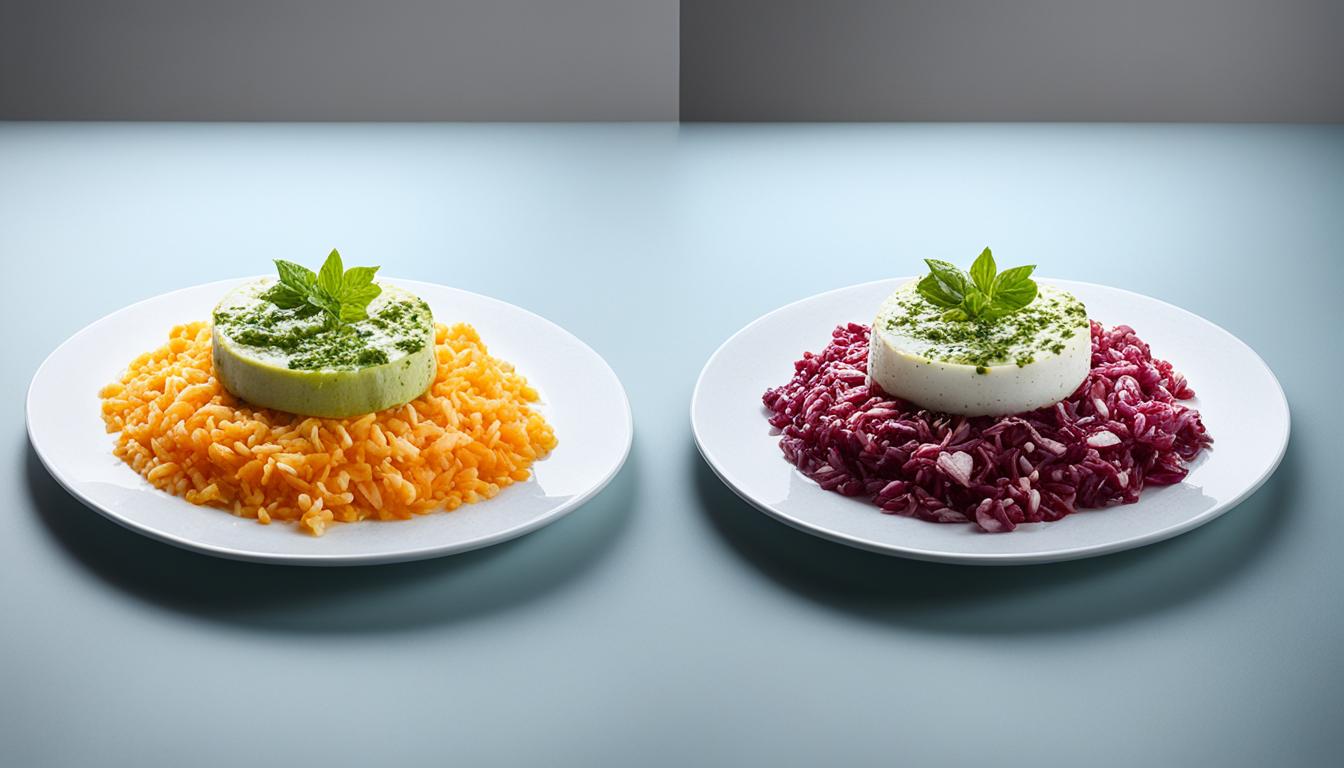Food photography and beverage photography have become popular subcategories in professional photography. To capture stunning images of cuisine, photographers must master the art of utilizing light, angles, and textures effectively. The choice of lighting and backgrounds can greatly impact the overall presentation and appeal of the food. In this article, we will explore essential lighting techniques and tips to help you elevate your food photography game.
Key Takeaways:
- Proper lighting and angles are crucial for capturing appetizing food photos.
- Natural light is often preferred, but artificial lighting can also be used effectively.
- Pay attention to details like composition, garnishes, and textures to enhance the overall appeal.
- Choose suitable backgrounds and props to complement the dish being photographed.
- Understanding the impact of food photography on businesses, especially on social media, can help attract and engage customers.
What is Food Photography
Food photography is the art of capturing visually appealing images of food and beverages. It combines the skills of photography with a passion for food, aiming to highlight textures, colors, and arrangements that make the subjects irresistible.
In recent years, food photography has gained tremendous popularity due to social media platforms like Instagram and Pinterest. Skilled food photographers have the opportunity to work closely with chefs, food stylists, and marketing teams to create images that effectively showcase the dishes or beverages in the most captivating way.
Visual appeal is at the heart of food photography. From the smooth, velvety textures of desserts to the vibrant colors of fresh produce, every element of a dish contributes to its visual appeal. Skilled photographers strive to capture the essence of the dish, making it visually stunning and instantly mouthwatering.
Arranging the dish and choosing the right settings are crucial steps in food photography. Attention is given to every detail, ensuring that the dish is presented in the most appealing way. The composition of the image, the use of props, and the selection of backgrounds all play a role in creating a visually captivating representation of the food.
By employing various techniques and utilizing their creative vision, food photographers are able to bring dishes and beverages to life through their art. Whether it’s an intricately plated gourmet dish or a simple, rustic meal, food photography has the power to elevate the humblest of dishes and make them truly enticing.
Essential Food Photography Tips
When it comes to food photography, lighting is of utmost importance. Opting for natural light is often the best choice as it enhances the colors and textures of the dish. While shooting, experimenting with different angles can offer unique perspectives, capturing the food from its best side. Careful composition is crucial in drawing the viewer’s eye to the main subject, ensuring the dish takes center stage.
In food photography, attention to details can make all the difference. Focusing on garnishes, textures, and even the placement of individual ingredients can enhance the overall appeal of the dish, enticing viewers.
Choosing the right backgrounds and utilizing props can elevate the visual storytelling in food photography. Simple backgrounds that do not overpower the dish work best, allowing the main subject to shine. Incorporating props such as utensils or ingredients that relate to the dish can add depth and context to the composition.
“A great food photograph is like a well-composed symphony, with each element playing its part to create a visually harmonious experience.”
To capture stunning food photographs, mastering camera settings is essential. Adjusting settings such as aperture, shutter speed, and ISO can help you achieve the desired depth of field, sharpness, and exposure. Post-processing plays a significant role in bringing out the vibrancy and polishing the final image, so don’t hesitate to fine-tune your photos.
Camera Settings for Food Photography:
| Setting | Recommended Value |
|---|---|
| Aperture | Wide aperture (low f-stop number) for shallow depth of field, emphasizing the main subject. |
| Shutter Speed | Fast enough to eliminate camera shake (consider using a tripod), but not too fast to capture motion blur if desired. |
| ISO | As low as possible to reduce noise, but high enough to maintain proper exposure. |
| White Balance | Adjust according to the lighting conditions to maintain accurate color representation. |
By incorporating these essential tips into your food photography workflow, you’ll be well on your way to capturing appetizing images that make viewers’ mouths water.
Perfecting Food Photography Backgrounds
When it comes to food photography, the right background can make all the difference. Simple backgrounds are ideal as they allow the dish to take center stage and be the star of the photo. Opt for plain or neutral colors like white, grey, or beige to create a clean and minimalistic look.
However, incorporating textures, patterns, and different materials into your background can add depth and interest to your images. Wooden surfaces, such as rustic cutting boards or reclaimed barn wood, can bring warmth and a natural feel to the composition.

Moreover, fabric backgrounds in soft and muted tones can add a touch of elegance and sophistication. Consider using linen or burlap for a natural and organic look, or experiment with silky fabrics for a more luxurious aesthetic.
If you’re looking to add a touch of sophistication and class to your food photography, tile or marble backgrounds can do the trick. These materials can create a sleek and polished look, elevating the overall presentation of your dishes.
When using textured or patterned backgrounds, it’s important to ensure that they complement and enhance the dish being photographed. The background should not overpower the food itself, but rather create a harmonious visual narrative.
Summary:
In summary, when perfecting your food photography backgrounds, opt for simple and clean designs that allow the dish to shine. Experiment with different materials, such as wooden surfaces, fabric, tile, or marble, to add depth and interest to your images. Ensure that your chosen background complements the dish and enhances its visual appeal. Remember, the background should always enhance, not overpower, the star of the show: the food.
How to Improve Food Photography
In food photography, capturing captivating images requires attention to various elements, including lighting, camera stability, manual settings, and color accuracy. By implementing the following techniques, you can enhance the overall quality of your food photographs.
1. Harness the Power of Natural Lighting
Utilizing natural lighting can lend a soft and diffused look to your food photographs. Position your subject near a window or in a well-lit area to make the most of this type of lighting. Experiment with different angles and observe how the light interacts with the food, enhancing its textures and colors.
2. Stabilize Your Camera with a Tripod
Using a tripod is crucial for achieving sharp and clear images. It helps to minimize camera shake, especially when shooting in low light conditions or when using longer shutter speeds. A stable camera setup allows you to focus on composing the perfect shot without worrying about unwanted blurriness.
3. Take Control with Manual Mode
Shooting in manual mode gives you complete control over your camera settings, allowing you to tailor each aspect to suit your vision. Adjusting the aperture enables you to control depth of field, highlighting specific elements of the dish. Manipulating the shutter speed helps freeze motion or create beautiful motion blur effects, adding dynamism to your photographs. The ISO setting determines the sensitivity of your camera’s sensor to light, allowing you to balance exposure in various lighting conditions.
4. Achieve Accurate Colors with White Balance
Adjusting the white balance is essential for capturing accurate colors in your food photographs. Different lighting conditions can cast varying color temperatures, which may result in unrealistic or unappetizing hues. Use the white balance setting in your camera to correct the colors, ensuring that the food appears visually appealing and true to life.
| Camera Setting | Purpose |
|---|---|
| Aperture | Determines depth of field, highlighting specific elements of the dish. |
| Shutter Speed | Controls motion blur and freezing action in your photographs. |
| ISO | Adjusts the sensitivity of the camera sensor to light, balancing exposure. |
| White Balance | Corrects color temperature to ensure accurate and appealing colors. |
By incorporating natural lighting, utilizing a tripod, shooting in manual mode, and adjusting white balance, you can elevate your food photography to the next level. These techniques empower you to create stunning, appetizing images that capture the essence of your culinary creations.
Impact of Food Photography on Businesses
Food photography is not only about capturing stunning images of delicious dishes; it also has a significant impact on businesses in the food industry. In today’s age of social media, where visual content is king, high-quality food photographs can be a game-changer for marketing strategies, customer engagement, and brand image.
When potential customers come across visually appealing food photographs, they are enticed to explore more about the dish or beverage. A well-composed and aesthetically pleasing image can make their mouths water and create a desire to try the food for themselves. This attraction can turn into new customers for the business.
Moreover, food photography plays a crucial role in maintaining customer loyalty. Regularly posting appetizing images of menu items not only keeps existing customers engaged but also reminds them of the enjoyable experiences they’ve had at the restaurant or food establishment.
Attractive food photographs also serve as powerful marketing tools. When used strategically on websites, social media platforms, or even printed materials like menus and advertisements, these images create an enticing visual narrative for potential customers. They showcase the quality and creativity of the food offerings, setting the business apart from competitors and establishing a strong brand image.
Here’s a closer look at how food photography impacts businesses in different ways:
Marketing Strategies:
- Food photographs can be used to create visually appealing marketing materials, both online and offline.
- High-quality images enhance the overall aesthetics of websites, social media profiles, and online advertisements, attracting more customers.
- Food photography helps in creating a consistent and enticing brand image, making the business stand out in a competitive market.
Customer Engagement:
- Visual content, including food photographs, increases engagement on social media platforms. Users are more likely to like, comment, and share attractive food images, which leads to increased organic reach and visibility.
- Regular posting of visually appealing food photographs keeps customers engaged and interested, encouraging repeat visits and purchases.
- Food photographs can create anticipation and excitement for seasonal promotions, limited-time offers, and new menu items.
Brand Image:
- Through food photography, businesses can showcase their unique style, creativity, and attention to detail in food preparation and presentation.
- Beautifully captured images communicate the quality and taste of the food, building a positive perception of the brand in the minds of the customers.
- Consistent and visually appealing food photographs contribute to brand recognition and establish the business as a trusted and reputable establishment.

Food photography is more than just a visual art form; it has the power to significantly impact businesses in the food industry. By investing in high-quality and aesthetically pleasing food photographs, businesses can strengthen their marketing strategies, enhance customer engagement, and establish a strong brand image that resonates with their target audience.
Best Practices for Social Media Food Photography
Social media platforms like Instagram and TikTok have transformed the way we showcase food photography. With countless food images flooding our feeds, it’s essential to stand out with visually appealing photos that capture attention. In this section, we will explore the best practices for social media food photography, including flat lay photography, staging, lighting, backgrounds, props, editing, and post-production.
Flat Lay Photography
Flat lay photography is a popular style for social media food photography. This technique involves capturing the food from above, arranging it on a flat surface, and shooting directly down. Flat lay photography allows you to showcase the entire dish, its vibrant colors, intricate details, and beautiful textures. By experimenting with different arrangements and compositions, you can create visually stunning images that entice your audience.
Staging
Proper staging is key to creating captivating food photos for social media. Pay attention to the overall composition and arrangement of the elements. Consider incorporating complementary props, such as utensils, cutting boards, napkins, or fresh herbs, to add depth and visual interest to your photos. Experiment with different placements and angles to find the most visually appealing composition.
Lighting
Lighting is crucial in food photography, and social media platforms are no exception. Natural light is the ideal choice as it provides a soft and diffused look. Find a well-lit area near a window or shoot outdoors during the golden hours of the day for the best results. If natural light is not available or consistent, consider investing in artificial lighting equipment such as a ring light or softbox to achieve professional-looking results.
Backgrounds
The choice of background can significantly impact the overall aesthetic of your food photos. Opt for clean and simple backgrounds that don’t distract from the main subject. Neutral colors like white, light grey, or pastels work well for a fresh and clean look. You can also experiment with textured surfaces like wooden boards, marble countertops, or fabric to add depth and visual interest to your compositions.
Props
Props can help enhance the storytelling aspect of your food photos. Choose props that are relevant to the food you’re photographing and complement the overall theme or mood of your image. For example, fresh ingredients, utensils, or condiments can add context and create a sense of authenticity. Be mindful not to overcrowd the composition, as the main focus should always be on the food itself.
Editing and Post-Production
Editing and post-production are essential steps in enhancing and optimizing your food photos for social media. Use editing software such as Adobe Lightroom or VSCO to adjust elements like brightness, contrast, saturation, and white balance. Be mindful of creating a consistent aesthetic across your feed by applying similar editing styles to your photos. Remember to keep it natural and avoid excessive filters or edits that can distort the true colors and textures of your dishes.
| Best Practices for Social Media Food Photography: | |
|---|---|
| 1. Flat lay photography | ✓ |
| 2. Staging | ✓ |
| 3. Lighting | ✓ |
| 4. Backgrounds | ✓ |
| 5. Props | ✓ |
| 6. Editing and Post-Production | ✓ |
By following these best practices, you can create stunning and engaging food photos that captivate your audience on social media. Experiment with different techniques, be consistent with your style, and don’t be afraid to let your creativity shine!
Conclusion
In conclusion, mastering lighting techniques and implementing essential tips can greatly enhance food photography. Whether you choose to work with natural light or utilize artificial lighting, understanding angles, composition, and details is key to capturing appetizing images. By carefully selecting and utilizing backgrounds and props, you can further enhance the visual storytelling in your photographs.
Food photography plays a significant role in businesses’ marketing strategies and customer engagement, particularly in the age of social media. The captivating images you create have the power to attract a wider audience and elevate your brand image. By following best practices for social media food photography, such as employing flat lay photography, staging your shots effectively, and utilizing proper lighting, backgrounds, and props, you can optimize your photographs for maximum impact on platforms like Instagram and TikTok.
Remember, high-quality and aesthetically pleasing images of food have the potential to make a lasting impression on potential customers and encourage repeat business. So, continue refining your photography skills, exploring new lighting techniques, and staying up-to-date with the latest trends in food photography to make a strong business impact in today’s competitive market.
FAQ
What is food photography?
Food photography is the art of capturing visually appealing images of food and beverages, highlighting textures, colors, and arrangements that make the subjects irresistible.
What are some essential food photography tips?
Some essential food photography tips include mastering lighting techniques, understanding angles and composition, paying attention to details, choosing appropriate backgrounds and props, and adjusting camera settings for optimal results.
How can backgrounds enhance food photography?
Backgrounds can enhance food photography by providing depth and interest to the images. Simple or neutral colors, wooden surfaces, fabric, tile, or marble can all be used to complement the dish being photographed.
What are the best lighting techniques for food photography?
The best lighting techniques for food photography include utilizing natural light for a soft and diffused look, using a tripod for stability, shooting in manual mode for full control, and adjusting white balance for accurate color representation.
How does food photography impact businesses?
Food photography plays a crucial role in businesses’ marketing strategies, customer engagement, and overall brand image. High-quality and aesthetically pleasing food images can attract and retain customers, especially on social media platforms.
What are the best practices for social media food photography?
Some best practices for social media food photography include using flat lay photography, proper staging, utilizing appropriate lighting, backgrounds, and props, and using post-production tools to enhance and optimize images for maximum engagement.
How Can I Use Natural and Artificial Light to Enhance Food Photography?
When it comes to natural and artificial light photography for enhancing food photography, it’s all about balance. Natural light can create a soft, flattering glow for daytime shots, while artificial light can provide consistent lighting for indoor or nighttime photography. Experiment with different combinations to find the perfect lighting for your food shots.




